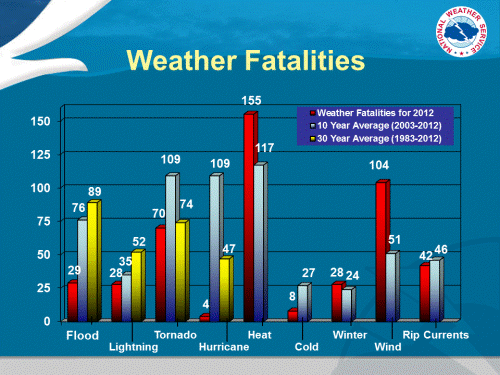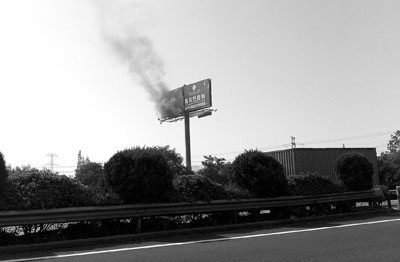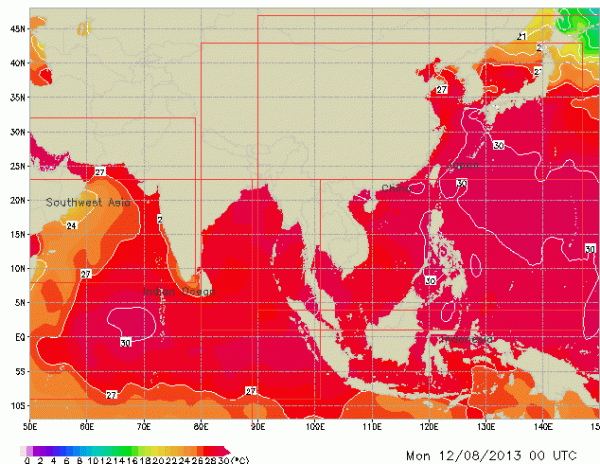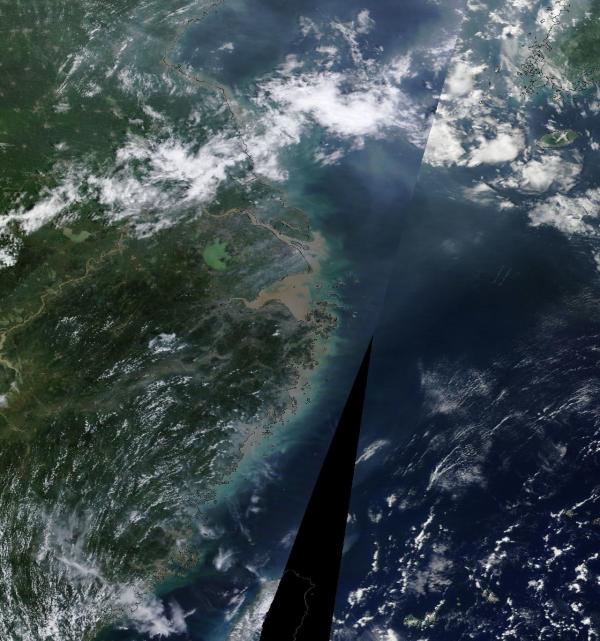In view of the seering temperatures in India it is worth rereading this article from 2013
China Falls Under Suspicion of Covering Up Deaths as Ocean Heat Dome Expands to Blanket Korea and Japan
US
Weather Fatalities by Type,,(Image
source: NOAA)
13
August, 2013
According
to recent reports from NOAA and the CDC,
heat is the most lethal form of weather in the United States. Death
and injury rates have been on the rise as human-forced temperature
increases have expanded, surging northward into major metro areas
such as New York City. The CDC report showed a growing number of heat
deaths and injuries for this northern region, with the New York Metro
area seeing an average of 13 deaths and over 440 heat injuries each
year during the period from 2000 to 2011. Nationwide, the average
number of heat fatalities surged to 117 during a period from 2003 to
2011.
Heatwaves
have hit the NYC region time and time again over the past decade,
driving the death and injury rate inexorably higher. However, the
heat impacting that area is paltry when compared to the extreme and
deadly temperatures that have broiled southeastern China since late
July. For more than three weeks, the Shanghai region of China has
experienced almost daily temperatures in excess of 100 degrees
Fahrenheit and sweltered under very high humidity for such hot
conditions. This
combination has pushed wet bulb temperatures (a measure that
simulates the temperature of human skin) into a range of 29 to 32
degrees Celsius,
very close to the lethal human limit of 35 degrees C.
On
Sunday, an extreme heat pulse sent thermometers soaring to 109
degrees Fahrenheit in the city of Shengxian — its hottest
temperature ever recorded and a scorching 32.3 degree wet bulb
temperature. Meanwhile, on the same day, Hangzhou had hit a new all
time record high temperature of 105.8 degrees Fahrenheit, the twelfth
time since July 24th that Hangzhou has tied or broken its old all
time temperature record which, in some cases, was set just the day
before.
High
heat and humidity of this kind is deadly to humans because as
temperatures approach 35 degree C wet bulb readings, it is nearly
impossible for the human body to carry away the excess heat it
generates through evaporation. Never has a wet bulb temperature of 35
degrees C been recorded by humans. However, climate scientists such
as James Hansen have asserted that it’s just a matter of time under
the current regime of human-caused warming before we hit that ominous
mark.
So
have thousands did?
Road
Sign Burns Under Record Heat in Shanghai Region (Image
source: Shenzhen
Daily)
As
reports of vehicle fires and sporadically smoldering infrastructure
in the massive Chinese heatwave flared, suspicions emerged that
Chinese officials are covering up what are potentially thousands of
heat-related deaths.
According
to Chinese news agencies, the official report is that about two dozen
have died so far in Shanghai’s record-shattering heatwave. But
similar heat in Europe and Russia resulted in tens of thousands of
deaths over the past decade. At issue is the fact that China’s
current record heat and humidity are at levels never before
experienced in its weather history and that this event is even more
intense than the deadly heatwaves of Europe and Russia. Add to this
extraordinarily dangerous event the fact that more than 400 million
people live in the region of China currently being socked by record
heat and the vague reports coming out of China seem highly
incongruent.
Never
before has such high wet bulb temperatures hit a region of so dense a
population. Yet China has only continued to report the vague ‘dozens’
estimate. It was this discrepancy thatcaused
WeatherUnderground Historian Christopher Burt to speculate that China
may be covering up a catastrophic rash of fatalities:
Eastern
China, where about 30% of the population of the country and 5% of the
global population reside (approximately 400 million people) has
undergone a heat wave unprecedented in its history. No one really
knows how many have died as a result of the heat wave (Chinese news
sources claim ‘about two dozen’), but statistically it is almost
certain that many thousands must have perished as the result of the
heat over the past month.
If
Christopher Burt’s, quite rational, analysis ends up proving true,
we can expect reports of fatalities to begin to slowly trickle out of
China. Misreporting and under-reporting of Chinese heatwave
casualties would also be yet one more instance of government
officials and mainstream media downplaying and under-reporting the
effects of catastrophic events related to human-caused climate
change. Such under-reporting is yet one more manifestation of a
dangerous and paralyzing denial that has so hampered an effective
response to these increasingly dangerous and self-inflicted events.
Making
such a call, however, is possibly premature as residents of this
region are more acclimated to excessive heat than Europeans or
Russians. As Burt notes:
One
thing to keep in mind, however, is that it is ALWAYS hot and humid in
eastern China during the summer (unlike Russia and Western Europe),
so perhaps the population has learned to adapt to extreme heat.
The
Ocean Heat Dome Expands to Cover Korea and Japan
 Ocean
Heat Dome Over China, Korea and Japan (Image
source: NASA/Lance-Modis)
Ocean
Heat Dome Over China, Korea and Japan (Image
source: NASA/Lance-Modis)
A
sprawling heat dome high pressure system that has scorched a region
stretching from coastal China to a large expanse of the Pacific Ocean
shifted eastward into Korea and Japan over the weekend. Southern
Japan saw temperatures surge into the 100s with Shimanto recording
the highest temperature ever measured in Japan of 105.8 degrees
Fahrenheit (41 degrees Celsius). Tokyo, meanwhile, broke the record
for its hottest minimum temperature at 86.7 degrees Fahrenheit (30.4
C).
South
Korea, over the same period, reported 8 deaths as temperatures soared
to 102.2 degrees Fahrenheit (39 C) in Busan. Temperatures in Seoul
hit the still hot, but more moderate, 90s (32 C +).
Both
South Korea and Japan are surrounded on multiple sides by water. This
geographic feature would usually provide a cooling effect as ocean
temperatures are typically many degrees cooler than land
temperatures. But, in this case, a massive heat dome is baking the
ocean itself to unprecedented high surface water temperatures. As a
result, a large area of open ocean now shows readings above 30
degrees Celsius ( 86 Fahrenheit). This extremely hot, near 90 degree
water, has formed the central pulse of the current heatwave even as
it has pumped extraordinarily humid air for such hot conditions over
adjacent land areas. A shift to the north of this large and still
growing region of extraordinarily hot ocean water led to the record
steamy conditions over Japan and Korea during the past few days —
both of which can expect little relief from the now, very hot, water.
Ocean
Heat Dome Puts Asia in Hot Water (Image
source: Weather
Online)
Forecasts
for Shanghai, Korea, and Japan call for slightly less sweltering
temperatures in the upper 90s with more isolated readings in the 100s
as clouds are expected to move in and increase chances of rainfall by
later this week. A slight improvement but a welcome change,
nonetheless. Meanwhile, hot ocean conditions create a risk for
continued very hot temperatures for much of this coastal region.
Road
Sign Burns Under Record Heat in Shanghai Region (Image
source: Shenzhen
Daily)
 Ocean
Heat Dome Over China, Korea and Japan (Image
source: NASA/Lance-Modis)
Ocean
Heat Dome Over China, Korea and Japan (Image
source: NASA/Lance-Modis)
Ocean
Heat Dome Puts Asia in Hot Water (Image
source: Weather
Online)







No comments:
Post a Comment
Note: only a member of this blog may post a comment.